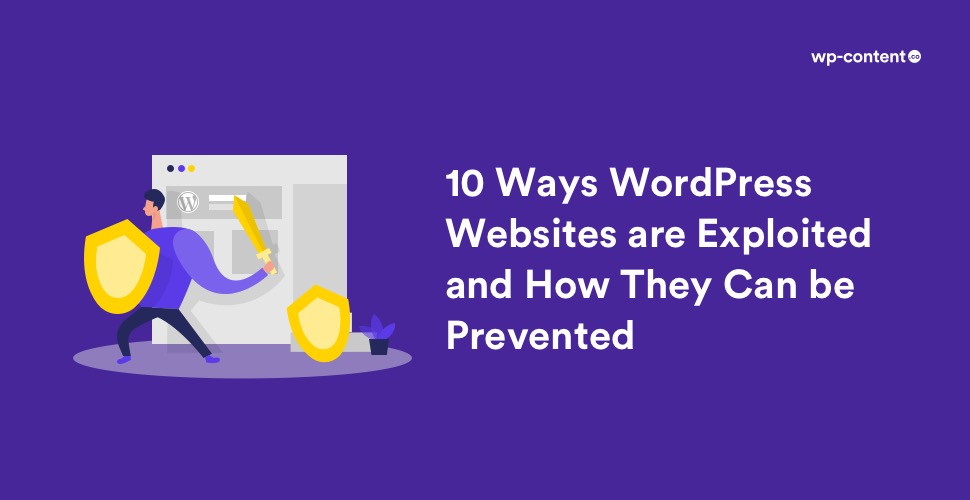WordPress powers nearly 42% of websites on the internet today and is on the top of the hit-list of hackers. If you own a WordPress website, you are sure to have experienced concerns about the safety and security of the website. We have already shared many articles on how to secure your website from hackers and now we will share with you some points on ways your website may get exploited and preventive measures to take.
Why do Hackers Attack Websites?
1. Monetary Gains
Making monetary gain is the most common reason behind these attacks. Many online stores collect and save confidential information such as payment cards, account credentials and personally identifiable information. Payment card details and personal information are hot commodities in dark markets; they are easy to sell and gain some quick cash.
The Drive-by-Downloads or Blackhat SEO campaigns are targeted for economic gains. A Drive-by-download is infecting the website visitors by deploying a payload while Blackhat SEO exploits your audience by directing them to pages that generate affiliate revenue.
2. Spread Malware
Your website is not safe even if it does not store any sensitive data. Hackers can host malware such as ransomware and crypto mining and then spread it with your website as the host. A compromised web server can also be used in hacking campaigns, with malicious attacks against other organizations originating from your web server.
3. Hacktivism
This is more to embarrass the website owners rather than exploit the visitors. The responsible parties here use it to propagate a religious or political agenda, show off their prowess to the hacking community or draw attention to some issues by broadcasting it to the world. It can also be a way for the hacktivists to express their opposition to something by displaying messages or images on the website of an organization they believe is doing something wrong.
4. Practice and Fun
Attackers are always looking for ways to improve their skills by discovering new vulnerabilities, practice newly learned skills in a real-world environment or test out the latest exploits in the wild. Small websites with little to no security measures are perfect for them to test their skills and make it perfect.
Common WordPress Security Issues
Let’s take a look at the various security issues plaguing WordPress.
1. Brute Force Attacks
Brute-force attacks are the simplest way an attacker uses to gain access to a website. It is a trial and error method to get through a website’s login page by entering multiple usernames and password combinations over and over until a successful combination is discovered.
By default, WordPress does not limit login attempts and bots exploit this feature. Even if a brute force attack is unsuccessful, it can still wreak havoc on your server and slow down your site. While you’re under a brute force attack, some hosts may suspend your account, especially if you’re on a shared hosting plan, due to system overloads.
2. Cross-Site Scripting Attacks
Cross-site scripting (XSS) is the most common way an attacker exploits WordPress websites. Here an attacker injects malicious JavaScripts in the web pages. These JavaScript lets him steal the user’s session cookies, which in turn can be used to impersonate the user. With active cookies in hand, an attacker can log into the wp-admin panel and exploit as he wishes.
XSS vulnerabilities may occur if input coming into web applications is not validated and output to the browser is not HTML encoded. It can have devastating consequences for an online business’s reputation and its relationship with its clients – user accounts may be compromised, Trojan horse programs activated and page content modified, misleading users into willingly surrendering their private data.
3. SQL Injections
SQL Injections enable an attacker to insert malicious SQL statements into the web application, potentially gaining access to sensitive data in the database or destroying this data. It is the result of loopholes in the backend coding. An attacker can easily abuse the input fields by inserting malicious code that could execute SQL commands and can create, retrieve, update, and even delete the data in the database.
An SQL injection attack can steal, modify or delete your website’s database. Often SQLi is a result of poor sanitation rules. Safer sanitization codes can work wonders in this case.
4. File Inclusion Vulnerability Issue
A file inclusion vulnerability allows an attacker to access unauthorized or sensitive files available on the web server or to execute malicious files on the web server by making use of the ‘include’ functionality. This attack is possible because some scripts allow “include” or “require” attributes. Hackers fool the website’s poor validation to inject alien files in targeted scripts.
File inclusion exploits are one of the most common ways an attacker can gain access to your WordPress website’s wp-config.php file. There are two types of File Inclusion attacks – Local File Inclusion (LFI) and Remote File Inclusion (RFI). LFI vulnerabilities allow an attacker to read and sometimes execute files on the victim machine. RFI vulnerabilities are easier to exploit but less common where the attacker is able to execute code hosted on their own machine.
Loopholes to Exploit in a WordPress Website
1. Weak Passwords
In spite of all the warnings about the security attacks, many people still use “12345”, “admin”, “password” as passwords. The address of the WordPress login is common knowledge and several hacking scripts are available to brute force common password combinations or try a list of passwords that have leaked from other sites.
This means that if you use a weak password, you are simply begging to be hacked. Brute force attacks can run millions of login tries against your site in a short amount of time. But unless your site notifies you about failed logins, you’d never know that a hacker script is trying to break into your site.
Solution: Use strong passwords with multiple types of characters, symbols or numbers that are harder to guess. Your password should be specific to your WordPress site and not used anywhere else. You can also consider using Password Managers and turning on multi-factor authentication or two-factor authentication.
2. Outdated WordPress Core, Themes, or Plugins
With the help of its vibrant community, WordPress regularly brings out new versions remedying the issues of its previous versions. But some of the users are not vigilant enough to update their websites leaving it to the mercy of attackers. What’s worse is that when an update is released, the contents and reasons for the updates are included in the change log which is available publicly. Everyone is now aware that a security flaw in the old version exists. Hackers find WordPress sites running on the old version. Once they find your site, it’s easy for them to hack because they know exactly what the vulnerability is.
The same process applies to themes and plugins as well. Most developers of themes and plugins constantly work towards improving their software and release updates regularly. By ignoring the update, you make the hacker’s job easy and invite them in.
Solution: Update your WordPress site, plugins and themes to keep it safe and secure against hackers. Updates keep your site running at optimal speed and performance. This helps boost your SEO rankings, thus, increasing your visibility, traffic, and revenue. Also, remove plugins and themes you’re no longer using.
3. Outdated PHP Versions
The PHP code extends to codes in your WordPress core, your themes, your plugins, and any other active application. PHP has a release life cycle to keep pushing things forward and making improvements. On reaching its end of life PHP stops the security support provisions for it. But some still continue with the outdated versions leaving their websites at risk. Vulnerabilities that are publicly known will NOT get fixed anymore and you’re literally inviting hackers to break into your site
Solution: Update your website to the latest PHP version. But before that ensure that you have created several backups.
4. Plugins and Themes from Untrustworthy Sources
There are thousands of free plugins and themes in the WordPress repository. Still some may download WordPress products from dodgy sites or get nulled or cracked or hacked versions of premium products from questionable sources for various shortsighted reasons like monetary gains. This is a sure way to introduce WordPress vulnerabilities to your websites.
Nulled plugins and themes may carry malware which cannot be detected very easily. If you are a very experienced developer with ample time on your hands, you can dig through the code and ensure it’s clean. Otherwise you are in a world of security trouble.
Solution: Only download and install WordPress plugins and themes from reputable sources, such as from the WordPress.org repository, or from premium companies with a good reputation.
5. Poor Quality Hosting
Since the server where your WordPress website resides is a target for attackers, using poor-quality hosting can make your site more vulnerable. While all hosts take precautions to secure their servers, not all are vigilant or dedicated enough to implement the latest security measures to protect websites on the server-level. In situations where multiple websites are stored on a single server without being segregated from each other correctly if one website is hacked, attackers may also gain access to other websites and their data.
Solution: Never opt for your WordPress hosting solely based on pricing. Select hosting providers that make security a priority and if you host websites for your clients, compartmentalize the different clients by creating different users for each client.
6. Absence of SSL/TLS Certificate
TLS (and its predecessor SSL) allows users to securely transmit sensitive data when using the HTTPS protocol. TLS helps provide an enhanced layer of protection by encrypting the otherwise readable data, making it difficult for hackers to obtain private information.
Sites without an SSL/TLS certificate do not encrypt information being sent between the browser and the server. This means that sensitive information including passwords and personal or payment information can be hacked as it is being transmitted over the internet.
Solution: Install and set up a secure certificate to secure your valuable data.
Conclusion
No software is perfect when it comes to security and that’s true even for WordPress. But most of these security issues can be avoided with WordPress security best practices and an awareness of the potential security risks. We believe we have given you an overview of the security risks that will help you secure your website and keep it away from the grubby hands of hackers.


